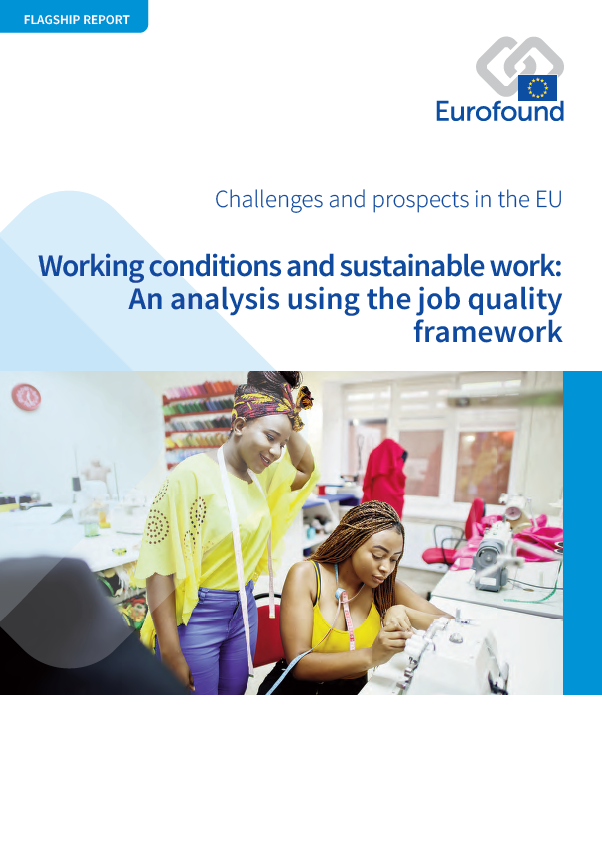
La presente relazione faro presenta una sintesi dei risultati principali della ricerca di Eurofound sulle condizioni di lavoro condotta nel periodo di programmazione 2017-2020. Delinea i progressi compiuti dal 2000 nel miglioramento delle condizioni di lavoro e valuta se tutti i lavoratori hanno beneficiato allo stesso modo dell’evoluzione positiva. Evidenzia quali gruppi sono maggiormente a rischio di sperimentare cattive condizioni di lavoro e di essere lasciati indietro. In considerazione dei cambiamenti nel mondo del lavoro, vengono individuate le sfide emergenti per una buona qualità del lavoro. La relazione fornisce anche prove relative a misure che potrebbero portare a un ulteriore miglioramento del lavoro e al raggiungimento di condizioni di lavoro eque per tutti nell’UE.
L’analisi mostra che, nel complesso, la qualità del lavoro nell’UE migliora, seppur lentamente. Tuttavia, non tutti i lavoratori beneficiano nella stessa misura di tale sviluppo. Inoltre, il genere, l’età e le condizioni contrattuali incidono in misura determinante sulle condizioni di lavoro. E se da un lato la digitalizzazione aiuta ad affrontare alcuni problemi relativi alla qualità del lavoro, dall’altro crea anche nuove sfide. La pandemia di COVID-19 ha esacerbato le tendenze, rafforzando le preoccupazioni ed evidenziando l’importanza di conseguire la qualità del lavoro per tutti.
Key findings
Oggi i lavoratori dell’UE godono in media di condizioni di lavoro migliori rispetto all’inizio del millennio. La qualità in termini di orario di lavoro è chiaramente migliorata. Ma anche l’ambiente fisico è migliore, soprattutto dove tale aspetto è più rilevante, ossia nelle occupazioni con un’esposizione elevata ai rischi fisici.
I lavori oggi richiedono più competenze e offrono maggiore autonomia rispetto al passato. Questo si riflette in un miglioramento dell’indice relativo a competenze e discrezionalità.
Lo sviluppo delle competenze dei lavoratori è ostacolato da un accesso iniquo alla formazione pagata dal datore di lavoro e dalla sua differente diffusione. I lavoratori più anziani partecipano meno alla formazione e si registra un crescente divario di accesso tra i dipendenti con condizioni contrattuali differenti (contratti di lavoro a tempo pieno rispetto a quelli a tempo parziale e contratti a tempo indeterminato rispetto a quelli a tempo determinato).
La persistente segregazione di genere nel mercato del lavoro si riflette nelle differenze a livello di qualità del lavoro tra uomini e donne. Tuttavia non esiste un vincitore assoluto. Il divario di genere può anche andare a scapito degli uomini, per esempio per quanto riguarda l’ambiente fisico.
Mentre le prospettive di carriera sono generalmente migliorate per uomini e donne, gli uomini hanno mantenuto un vantaggio in questa dimensione della qualità del lavoro. L’iniqua condivisione delle responsabilità di assistenza, che si manifesta con interruzioni di carriera più lunghe e un’organizzazione diversa dell’orario di lavoro per le donne, è la probabile causa.
Based on the European Working Conditions Survey (EWCS) 2015 analysis, the data below accompany Eurofound's flagship report on working conditions and sustainable work and focus on job quality for different occupational profiles.
- Data: Job quality in the EU
The flagship report also has the following list of tables and figures.
List of tables
Table 1: Change in the composition of the workforce, EU27 and the UK, 2002–2019
Table 2: Elements of the job demands–resources model based on the EWCS
List of figures
Figure 1: The seven dimensions of job quality and the indicators composing each dimension
Figure 2: Indexed change in job quality indices, EU27 and the UK, 2000–2015
Figure 3: Physical environment index: mean and standard deviation, by occupational category, EU27 and the UK, 2000–2015
Figure 4: Work intensity index: mean and standard deviation, by sector, EU27 and the UK, 2000–2015
Figure 5: Work intensity index: mean and standard deviation, by country cluster, EU27 and the UK, 2000–2015
Figure 6: Skills and discretion index: mean and standard deviation, by occupational category, EU27 and the UK, 2000–2015
Figure 7: Skills and discretion index: mean and standard deviation, by country cluster, EU27 and the UK, 2000–2015
Figure 8: Participation in paid training (%), by employment and contractual status, EU27 and the UK, 2005–2015
Figure 9: Associations between working time quality and occupational category, by country cluster
Figure 10: Working time quality index: mean and standard deviation, by country cluster, EU27 and the UK, 2000–2015
Figure 11: Long working hours (%), by employment status, EU27 and the UK, 2000–2015
Figure 12: Prospects index: mean and standard deviation, by occupational category, EU27 and the UK, 2005–2015
Figure 13: Prospects index: mean and standard deviation, by country cluster, EU27 and the UK, 2005–2015
Figure 14: Scores on Prospects index, by employment and sociodemographic characteristics, EU27 and the UK, 2005 and 2015
Figure 15: Receipt of support from colleagues and managers (%), EU27 and the UK, 2005–2015
Figure 16: Receipt of support from colleagues and managers (%), by age group, EU27 and the UK, 2005 and 2015
Figure 17: Exposure to adverse social behaviour (%), by gender, EU27 and the UK, 2010 and 2015
Figure 18: Perception of fair pay (%), by Member State and the UK, 2005–2015
Figure 19: Perceived appropriateness of pay, by country cluster, EU27 and the UK, 2005–2015
Figure 20: Job quality profiles: Scores on seven job quality indices, EU27 and the UK, 2015
Figure 21: Distribution of workers according to job quality profiles, EU27 and the UK, 2015
Figure 22: Job quality profiles of men, by job quality indices, EU27 and the UK, 2015
Figure 23: Job quality profiles of women, by job quality indices, EU27 and the UK, 2015
Figure 24: Distribution of employees according to predominant gender in occupation (%), by gender, EU27 and the UK, 2010 and 2015
Figure 25: Gender of immediate manager (%), by worker’s gender, EU27 and the UK, 2005–2015
Figure 26: Female employees reporting good prospects for career advancement and gender gap (%), EU27 and the UK, 2005–2015
Figure 27: Good prospects for career advancement (%), by age and gender, EU27 and the UK, 2005–2015
Figure 28: Job insecurity according to predominant gender in occupation (%), by gender, EU27 and the UK, 2010 and 2015
Figure 29: Employability according to predominant gender in occupation (%), by gender, EU27 and the UK, 2010 and 2015
Figure 30: Employees reporting difficulty making ends meet according to occupation type (%), by gender, EU27 and the UK, 2015
Figure 31: Employees reporting difficulty making ends meet according to household type (%), by gender, EU27 and the UK, 2015
Figure 32: Employee experience of selected emotional demands (%), by gender, EU27 and the UK, 2010 and 2015
Figure 33: Average weekly working hours of employees across the life course, by gender, EU27 and the UK, 2015
Figure 34: Flexibility to take time off according to predominant gender in occupation (%), by gender, EU27 and the UK, 2010 and 2015
Figure 35: Additional components of earnings from main job (%), by gender, EU27 and the UK, 2005–2015
Figure 36: Employees’ perception of their work–life balance (%), by age, EU27 and the UK, 2015
Figure 37: Employees’ participation in training (%), by age and training classification, EU27 and the UK, 2015
Figure 38: Associations between demands and resources and workers’ health and well-being
Figure 39: Proportion of workers with flexitime schedules and engaged in TICTM (%), EU27 and the UK, 2015
Figure 40: Workers reporting work–life balance problems (%), by work arrangement and presence or absence of children, EU27 and the UK, 2015
Figure 41: Multiple-job holders as a proportion of total employment (%), by gender and country, EU27 and the UK, 2018
Figure 42: Job quality profiles of multiple-job holders’ main jobs, by gender, EU27 and the UK, 2015
Figure 43: Job quality of selected critical occupations in relation to the workforce average
Figure 44: Emotional demands on ISWs and extent of those demands (%), EU27 and the UK, 2015
- Number of pages
-
80
- Reference nº
-
EF20021
- ISBN
-
978-92-897-2150-9
- Catalogue nº
-
TJ-03-21-030-EN-N
- DOI
-
10.2806/938302
- Permalink
Members of Eurofound’s Management Board provide their reactions to and insights into Eurofound’s 2021 flagship report on Working conditions and sustainable work: An analysis using the job quality framework.
- Impact of the Covid-19 pandemic
Interview with Juha Antila, Head of Research and Development SAK, Central Organisation of Finnish Trade Unions.
- Digitalisation
Interview with Mario van Mierlo, Deputy Director, Social Affairs, The Dutch Confederation of Industry and Employers (VNO-NCW).
- Making work sustainable
Interview with Alain Piette, Ergonomist at the Belgian Federal Public Service Employment, Labour and Social Dialogue.
- Role of different actors in improving job quality
Interview with Rebekah Smith, Deputy Director for Social Affairs, BusinessEurope.
- Persisting challenges
Interview with Nelson Ferreira, Deputy General Inspector ACT, Portugal Labour Conditions Authority.
- Remote working
Interview with Esther Lynch, Deputy General Secretary of the European Trade Union Confederation (ETUC).
Cite this publication
Eurofound (2021), Working conditions and sustainable work: An analysis using the job quality framework, Challenges and prospects in the EU series, Publications Office of the European Union, Luxembourg.
